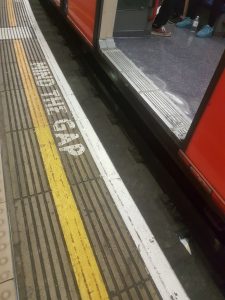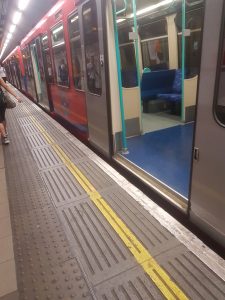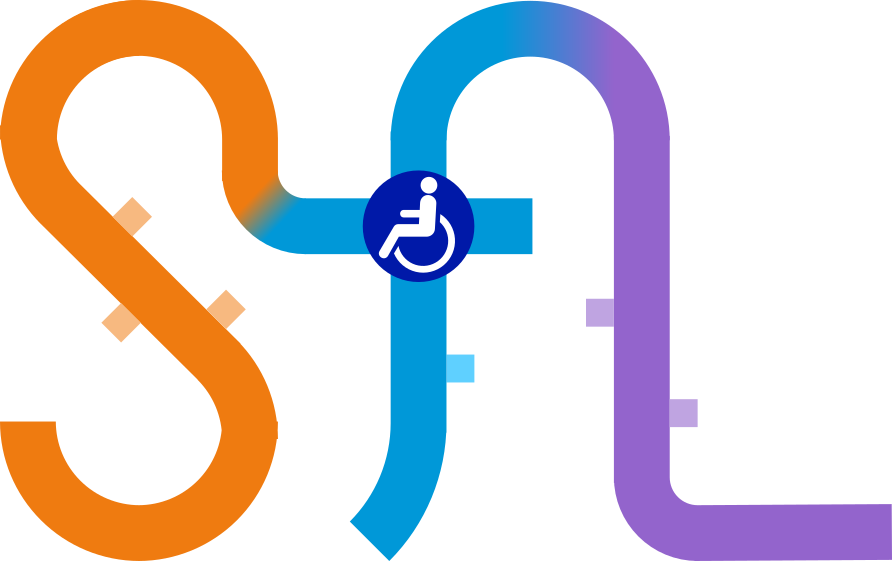It is finally time to talk about the concept of level boarding, including its history, major factors and challenges, while also examining where level boarding exists and various solutions that could expand the provision of level boarding across London. I have talked about level boarding several times before when discussing degrees of step-free access, as level boarding is when wheelchair users are able to board a train without requiring any outside assistance, such as a manual boarding ramp. In an ideal world, the interface between the train and the platform would look similar to that found in a lift, where the lift lines up seamlessly with the floors of the building.
 Degrees of step-free access on SFL map. While the dark blue blob indicates consistent level boarding, the light blue one may require a ramp on some parts of the platform, and allow for level boarding at others.
Degrees of step-free access on SFL map. While the dark blue blob indicates consistent level boarding, the light blue one may require a ramp on some parts of the platform, and allow for level boarding at others.
Unfortunately, the reality is that this interface, known in the rail industry as the Platform Train Interface (PTI), is highly variable and depends on a multitude of complicated factors, including everything from rail standards, train design, platform shape, and even the amount of people on a train. Coupled with the fact that most of London’s rail network was built during a time when step-free access was not even considered, it should not be surprising that level boarding in London, along with general step-free access, is relatively new and very difficult to implement. This introductory post will explain the concept of level boarding and detail its main challenges and factors.
While step-free access refers to making stations accessible to every platform and making it possible for persons with reduced mobility to board trains, it doesn’t necessarily guarantee level boarding. In fact, manual boarding ramps are widely used, particularly on Network Rail-owned stations and on several Underground lines.


Manual boarding ramp (left) and PTI (right) at Oxford Circus on the Bakerloo Line
In many cases, even newly redeveloped stations will often require manual boarding ramps, such as Blackhorse Road on the Overground’s GOBLIN. Before going into detail as to why this is the case, it is important to establish how the UK rail industry defines level boarding.
The independent body responsible for the standards, regulations, and operating procedures on the UK’s railways is the Rail Safety and Standards Board (RSSB). Generally, the PTI can be described using two values: the “step” and the “gap”. The “step” refers to the vertical distance between the platform and train floor, while the “gap” refers to the horizontal distance. It is this same “gap” that gave rise to the famous phrase “Mind the gap,” which is heard all across Central London due to highly curved platforms.
The RSSB’s requirement for level boarding for any rail system specifies a maximum step of 50 mm and a gap of 75 mm. This means that level boarding does not actually need to be completely level, which may cause discomfort for some wheelchair users who may still struggle with the small step or whose wheels are small enough to get stuck in a 75 mm gap. Nevertheless, I will use this definition to maintain consistency with current standards.
Challenges
There are many factors that determine the feasibility of level boarding and explain why it has not yet been widely adopted in London. The most noticeable factors are probably the step and the gap between the platform and train as well as the design of the trains themselves.
Generally, services running on Network Rail-owned routes, including National Rail services, TfL rail and most of the Overground, have a rolling stock, or train fleet, with floors that are on average a whopping 185 mm higher than the platforms.
 New Great Western Railway suburban train at Ealing Broadway. Notice the excessive step onto the train, as well as the “Mind the Step” warning
New Great Western Railway suburban train at Ealing Broadway. Notice the excessive step onto the train, as well as the “Mind the Step” warning
On the Underground, there is considerable variation with regards to step size, with platform levels ranging from being above, level to, or below the train floors depending on the station and rolling stock.
 The Piccadilly line at Acton Town, were the platforms are above train floor
The Piccadilly line at Acton Town, were the platforms are above train floor
Also, both systems can exhibit incredibly large gaps at platforms that are sufficiently curved, such as parts of Clapham Junction and Bank on the Central line.
Finally, there are many different types of rolling stock in London, and unfortunately, not all of them have basic accessibility requirements, such as wheelchair spaces. Also, a large class of trains have small internal steps into the train which are bridged over by manual boarding ramps but would impede any type of independent boarding.
 Older Great Western Railway train at Reading West with internal step
Older Great Western Railway train at Reading West with internal step
The presence of the step and the gap is originally due to the nonstandard manner in which London’s early rail network was built. For example, platform heights differed depending on the company that built the particular line, as the network was made by competing companies. Since there was no real interest at the time in providing access for individuals with reduced mobility, train floors were by convention a step or two above the platform level, a tradition that unfortunately has not died down over time. In fact, while a standard platform height of 915 mm was eventually established as a compromise and compliance is slowly increasing, full-sized trains still have an average train floor height of around 1100 mm.
 Position of train footsteps relative to the standard platform. As you can see there is a very large variation for both the vertical and lateral positions, with no trains coming close to achieving level boarding (source)
Position of train footsteps relative to the standard platform. As you can see there is a very large variation for both the vertical and lateral positions, with no trains coming close to achieving level boarding (source)
In turn, curved platforms arose mainly due to spatial constraints, where the line needed to follow a particular alignment which forced the station to be built on a curve. This is most evident at Bank, where the platforms were made very curved in order to avoid the existing underground vaults at the Bank of England.

 Examples of curved platforms at Bank (top) and Tower Hill (bottom). At Bank, the curve is so great that it will probably never be accessible in its current form, while at Tower Hill, the curve is mild enough to have some areas of level boarding throughout the platform
Examples of curved platforms at Bank (top) and Tower Hill (bottom). At Bank, the curve is so great that it will probably never be accessible in its current form, while at Tower Hill, the curve is mild enough to have some areas of level boarding throughout the platform
Attempting to realign these curves would require massive disruptions for the whole line and would probably only be justified if the entire station were being redeveloped.
Existing System
And so, under a railway system compliant with all of today’s regulations, it appears that there would still be no active provision for large-scale level boarding, which seems outrageous for a supposedly modernising railway network. Still, there are several important lines and sections where level boarding has been achieved. For example, newer lines, such as Tramlink and the DLR, as well as new sections of existing lines, including the Jubilee line extension and the Piccadilly line’s Heathrow branch, were all built with level access in mind. The prerequisites for this were that trains on each line would be independently accessible, have the same floor height and width, and platform curvature would be strictly limited. This allowed the platform height to be tailored to the new line, while also restricting the type of rolling stock that could travel on it.
 Level boarding at the DLR in Bank
Level boarding at the DLR in Bank
In addition to new infrastructure, it was also possible to extend level boarding to existing lines that had a uniform rolling stock (where all the trains have the same boarding interface) at stations with minimal curvature. This is why a large number of step-free stations on the Underground have level boarding. The main exceptions are where there is track or platform sharing between lines with different-sized trains, there is too much platform curvature, or the line uses trains that do not yet offer sufficient accessibility (namely the Bakerloo and Central lines). In these cases, level access was achieved by bringing in new trains with lower floors, raising all or part of the platform via platform humps, closing the gap by widening the platform or adding gap fillers, or a mixture of these methods.
 Level boarding via new trains at Ealing Broadway on the District line
Level boarding via new trains at Ealing Broadway on the District line
 Level boarding via platform hump at Victoria on the Victoria line
Level boarding via platform hump at Victoria on the Victoria line
Outside of the Underground, these criteria become almost impossible to meet, since most lines see a mixture of services and trains (either passenger or freight), which often have differences in height and width. The two sections where the prerequisites are met are in the Thameslink core and the Overground’s East London Line core, which have received raised platforms or platform humps.

 Level Boarding at Blackfriars on Thameslink (top) and Whitechapel on the Overground (bottom)
Level Boarding at Blackfriars on Thameslink (top) and Whitechapel on the Overground (bottom)
Although there are other sections, such as distant branch lines or terminal stations in Outer London, where level boarding could be feasible using these methods, it is not likely to happen until there is a way to bring level boarding to the more central rail corridors.
Going Forward
But what happens to the rest of the network? The first instinct may be to simply change the platform height standard to around 1100 mm to achieve closer level boarding. However, a study published by the RSSB in 2008 looking at the possibility of a 1115 mm standard concluded that, even disregarding the high cost, this would create many unintended consequences. First of all, the PTI varies considerably between different train designs, as some may have slightly lower floors, have footsteps that stick out of the train body, or even have internal steps near the doors. This would mean that raising the platforms would not lead to level boarding for all trains and it may even lead to certain trains coming in contact with the platform, which is known as fouling. Fouling is especially problematic when considering freight trains, which are particularly bulky, and passenger trains that pass non-stop through a station, since they experience considerable swaying at high speeds.
 Freight train at Reading
Freight train at Reading
Also, modifying or getting new trains at the same time to match the platform is often not practical due to reasons I will detail in my upcoming rolling stock post.
What this means is that to make this platform alteration work, one would also need to cut the platform back approximately 150 mm, which would inevitably increase the gap between the trains and the platform. This would not only defeat the purpose of level boarding, but would also make platforms dangerously narrow and less accommodating for all passengers.
 Necessary platform cutback if the standard platform height were raised (from RSSB report)
Necessary platform cutback if the standard platform height were raised (from RSSB report)
This shows that achieving level boarding in a legacy railway system is not as simple as just making the platform the same level as the trains. Instead, what would be required are more creative solutions that can accommodate trains of different sizes and undesirable platform curvature, such as moveable gap fillers, standardised train floor heights, selective lower floor heights, and trains that can lean into the platform. These solutions, and more, will be described in detail in the next post, along with the current developments that will put more pressure on the industry to stop ignoring the lack of level boarding on the railway.


4 comments